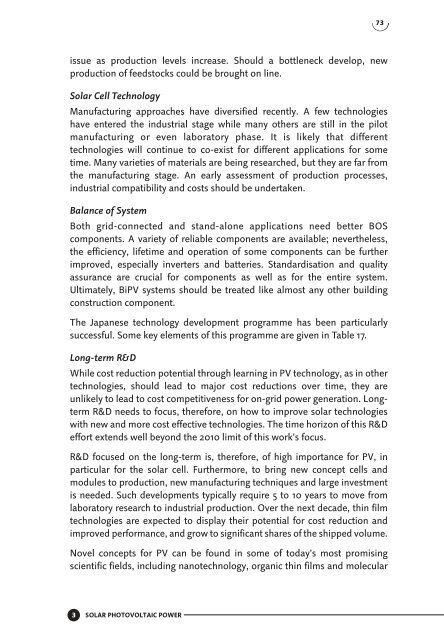Technology Status - NET Nowak Energie & Technologie AG
Technology Status - NET Nowak Energie & Technologie AG
Technology Status - NET Nowak Energie & Technologie AG
You also want an ePaper? Increase the reach of your titles
YUMPU automatically turns print PDFs into web optimized ePapers that Google loves.
issue as production levels increase. Should a bottleneck develop, new<br />
production of feedstocks could be brought on line.<br />
Solar Cell <strong>Technology</strong><br />
Manufacturing approaches have diversified recently. A few technologies<br />
have entered the industrial stage while many others are still in the pilot<br />
manufacturing or even laboratory phase. It is likely that different<br />
technologies will continue to co-exist for different applications for some<br />
time. Many varieties of materials are being researched, but they are far from<br />
the manufacturing stage. An early assessment of production processes,<br />
industrial compatibility and costs should be undertaken.<br />
Balance of System<br />
Both grid-connected and stand-alone applications need better BOS<br />
components. A variety of reliable components are available; nevertheless,<br />
the efficiency, lifetime and operation of some components can be further<br />
improved, especially inverters and batteries. Standardisation and quality<br />
assurance are crucial for components as well as for the entire system.<br />
Ultimately, BiPV systems should be treated like almost any other building<br />
construction component.<br />
The Japanese technology development programme has been particularly<br />
successful. Some key elements of this programme are given in Table 17.<br />
Long-term R&D<br />
While cost reduction potential through learning in PV technology, as in other<br />
technologies, should lead to major cost reductions over time, they are<br />
unlikely to lead to cost competitiveness for on-grid power generation. Longterm<br />
R&D needs to focus, therefore, on how to improve solar technologies<br />
with new and more cost effective technologies. The time horizon of this R&D<br />
effort extends well beyond the 2010 limit of this work’s focus.<br />
R&D focused on the long-term is, therefore, of high importance for PV, in<br />
particular for the solar cell. Furthermore, to bring new concept cells and<br />
modules to production, new manufacturing techniques and large investment<br />
is needed. Such developments typically require 5 to 10 years to move from<br />
laboratory research to industrial production. Over the next decade, thin film<br />
technologies are expected to display their potential for cost reduction and<br />
improved performance, and grow to significant shares of the shipped volume.<br />
Novel concepts for PV can be found in some of today’s most promising<br />
scientific fields, including nanotechnology, organic thin films and molecular<br />
3<br />
SOLAR PHOTOVOLTAIC POWER<br />
73







